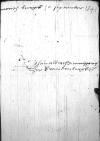List #4105
Johann Albrecht of Brandenburg-Ansbach do Ioannes DANTISCUSHalle an der Saale, 1541-09-10
| odebrano Heilsberg (Lidzbark Warmiński), 1541-11-27 Rękopiśmienne podstawy źródłowe:
Pomocnicze podstawy źródłowe:
| ||||||
Tekst + aparat krytyczny + komentarzZwykły tekstTekst + komentarzTekst + aparat krytyczny
[Er]wyrdigen meynen gutten hern und ...n
... [E]ygen handen
Erwyrdiger in Gott wesunderer gutter herre unnd freundt.
Wans Euer Lieb nach allem irem gefallen gluckselig und wol zustundt, / auch frisch und gesundt weret, horet ich von herzen gern und las Euer Lieb wyssen, das ich istz von den genach Gottes mich frisch und gesundt pin. Gott hab lobe unnd geb lang, damit mir noch einmal mit freuden einander sehen mochten und ein gutten muthe miteinanter haben, / dan mich warlich thungt, ich hab Euer Lieb in fil fil garen nit gesehen. /
So pin ich istz im landt zu
Datum



